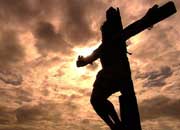One of the
oddities of the Resurrection of the Jesus was the body that Jesus now had.
It was indeed a
physical body that could be touched (Matthew 28:9; Luke 24:39) and could touch
things (Luke 24:30; John 21:13). He could breathe (John 20:22) and he could eat
(Luke 24:41-43; John 21:12-15). It was a physical body in every sense that one
can imagine. Indeed, it was the very same body that Jesus had before he was
resurrected. We know this from the fact that it had the scars of the
crucifixion (Luke 24:39; John 20:20, 27).
Yet, while it
was the same body, it was also a changed body. The people who knew him best did
not always recognize him at first (Luke 24:15-31; John 20:4). The body was able
to appear and disappear (Luke 24:31, 36; John 20:19, 26).
This was not
simply a resuscitated corpse (John 11:44) but a complete retranslation of the
same body in a new context. This is something that had never happened before
and has yet to happen again.
Interestingly
enough, in the pre-modern world, particularly among the Greco-Romans, the idea
of disembodied ghosts was not an unbelievable idea. However, the concept of a
resurrected physical body was considered complete nonsense by those within the Greek worldview (Acts 17:18, 32). The idea that humans are
holistic beings in which body and spirit are indivisible is a Hebrew concept.
The body does not have a soul; the body is a soul (נֶפֶשׁ nephesh; ψυχή psyche).
The importance
of this for Christians is that while everyone dies and both body and spirit afre destroyed and "sleep" in the earth, one day all believers will be resurrected (both
body and spirit) into glorified bodies like Jesus (1 Corinthians 15:52; 2
Corinthians 3:18). This is why Jesus is referred to as the first fruits of the
resurrection (1 Corinthians 15:20, 23).
 "Thinking Eternally, Acting Locally." - Neal August
"Thinking Eternally, Acting Locally." - Neal August
No comments:
Post a Comment